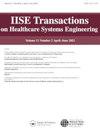Outpatient appointment scheduling with walk-ins in fixed arrival periods
IF 1.5
Q3 HEALTH CARE SCIENCES & SERVICES
IISE Transactions on Healthcare Systems Engineering
Pub Date : 2020-08-24
DOI:10.1080/24725579.2020.1801909
引用次数: 2
Abstract
Abstract We study the problem of determining the optimal appointment scheduling decision in the presence of patient’s no-show behavior and random walk-ins arriving in a specified time window. We propose a two-stage optimization model to determine the optimal time window for the arrival of walk-ins and corresponding optimal appointment schedule for regular patients, to minimize the total cost of patients’ waiting time, and physician’s idleness and overtime. We demonstrate that the objective function for the first stage optimization problem is multimodular and propose a variable neighborhood descent (VND) algorithm to solve the proposed model. The VND algorithm performs well compared with some common local search algorithms. Our analysis suggests that the policy that stipulates an optimal time window for the arrival of walk-ins performs better than the general random walk-in arrival (open walk-in) policy when the arrival rate of walk-ins is moderate relative to the clinic’s capacity. In particular, utilizing the optimal time window policy can lead to a fair reduction in system cost and preservation of an increased level of patients’ access to care.门诊预约安排在固定的到达时间内进行预约
摘要我们研究了在特定时间窗口内出现患者不露面行为和随机进入的情况下,确定最佳预约安排决策的问题。我们提出了一个两阶段优化模型,以确定普通患者到达的最佳时间窗口和相应的最佳预约时间表,从而最大限度地减少患者等待时间、医生空闲和加班的总成本。我们证明了第一阶段优化问题的目标函数是多模的,并提出了一种可变邻域下降(VND)算法来求解所提出的模型。与一些常见的局部搜索算法相比,VND算法表现良好。我们的分析表明,当预约到达率相对于诊所的容量适中时,为预约到达规定最佳时间窗口的政策比一般的随机预约到达(开放预约)政策表现更好。特别是,利用最佳时间窗口政策可以公平地降低系统成本,并保持患者获得护理的机会。
本文章由计算机程序翻译,如有差异,请以英文原文为准。
求助全文
约1分钟内获得全文
求助全文
来源期刊

IISE Transactions on Healthcare Systems Engineering
Social Sciences-Safety Research
CiteScore
3.10
自引率
0.00%
发文量
19
期刊介绍:
IISE Transactions on Healthcare Systems Engineering aims to foster the healthcare systems community by publishing high quality papers that have a strong methodological focus and direct applicability to healthcare systems. Published quarterly, the journal supports research that explores: · Healthcare Operations Management · Medical Decision Making · Socio-Technical Systems Analysis related to healthcare · Quality Engineering · Healthcare Informatics · Healthcare Policy We are looking forward to accepting submissions that document the development and use of industrial and systems engineering tools and techniques including: · Healthcare operations research · Healthcare statistics · Healthcare information systems · Healthcare work measurement · Human factors/ergonomics applied to healthcare systems Research that explores the integration of these tools and techniques with those from other engineering and medical disciplines are also featured. We encourage the submission of clinical notes, or practice notes, to show the impact of contributions that will be published. We also encourage authors to collect an impact statement from their clinical partners to show the impact of research in the clinical practices.
 求助内容:
求助内容: 应助结果提醒方式:
应助结果提醒方式:


